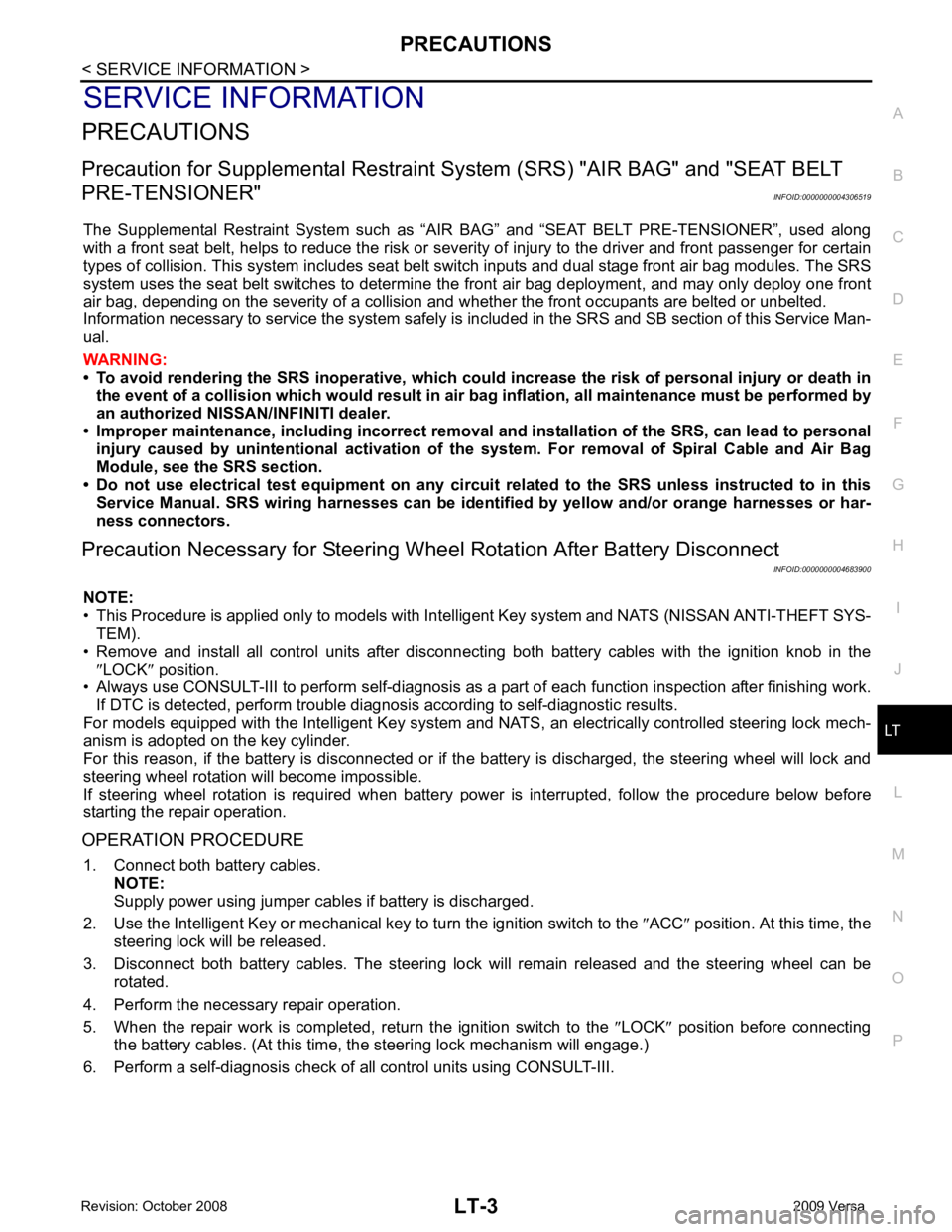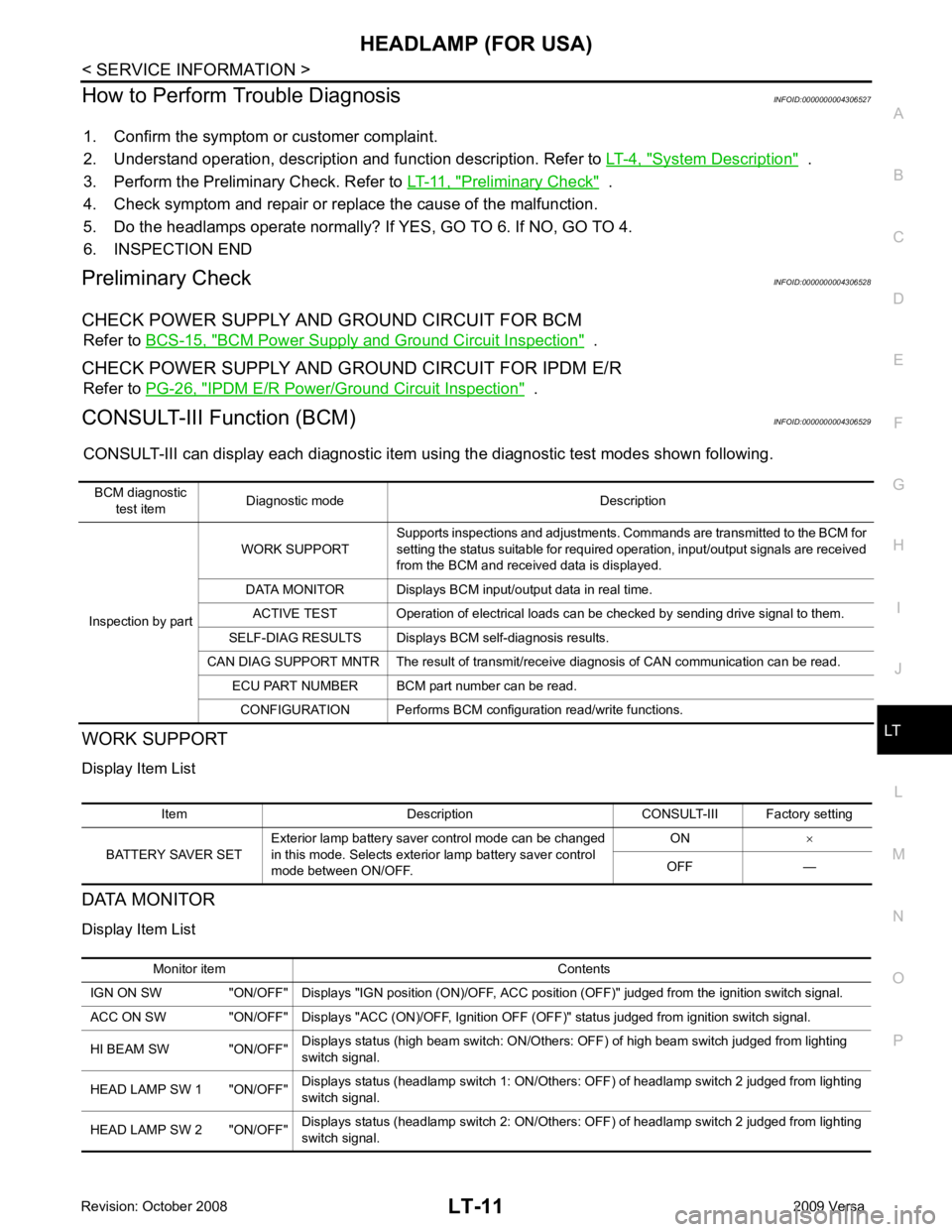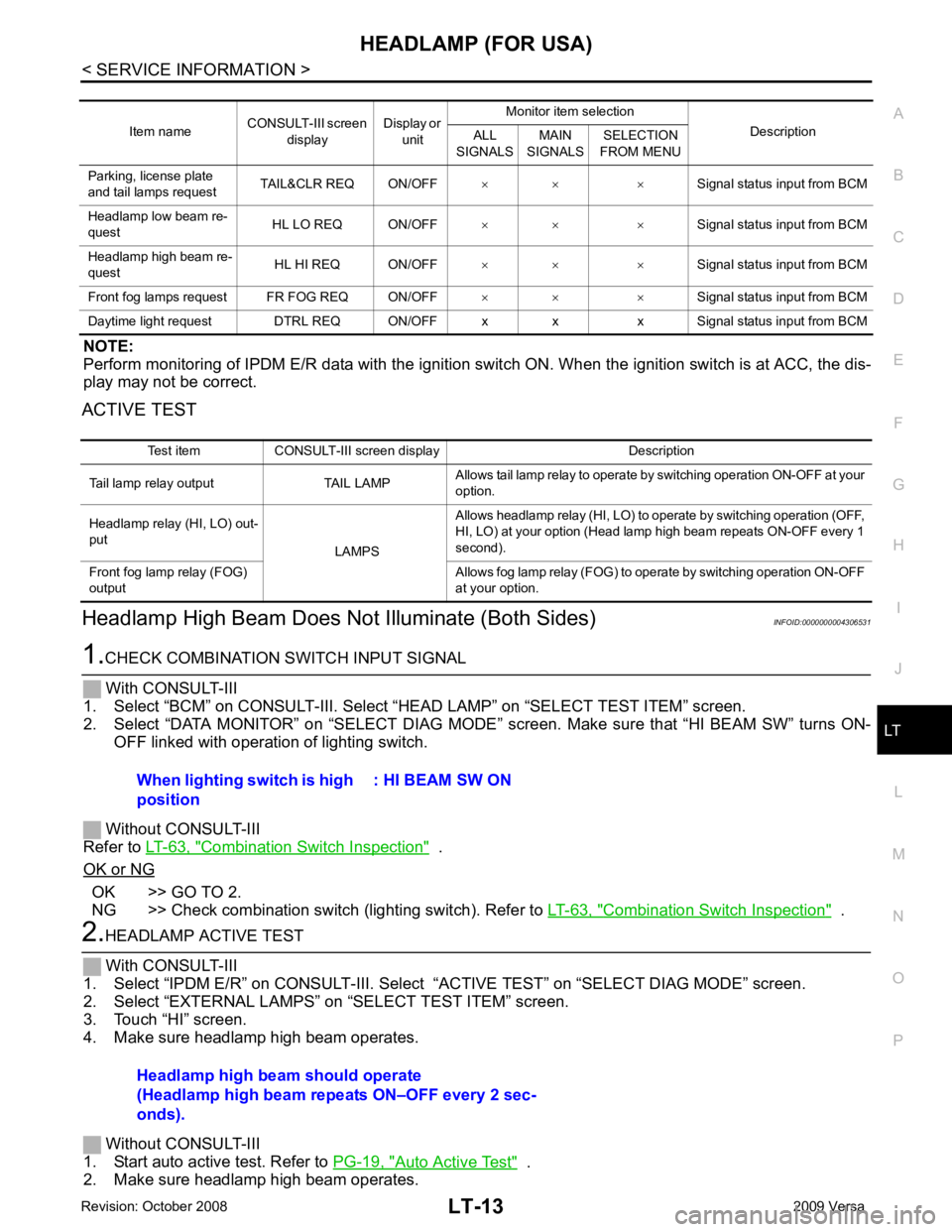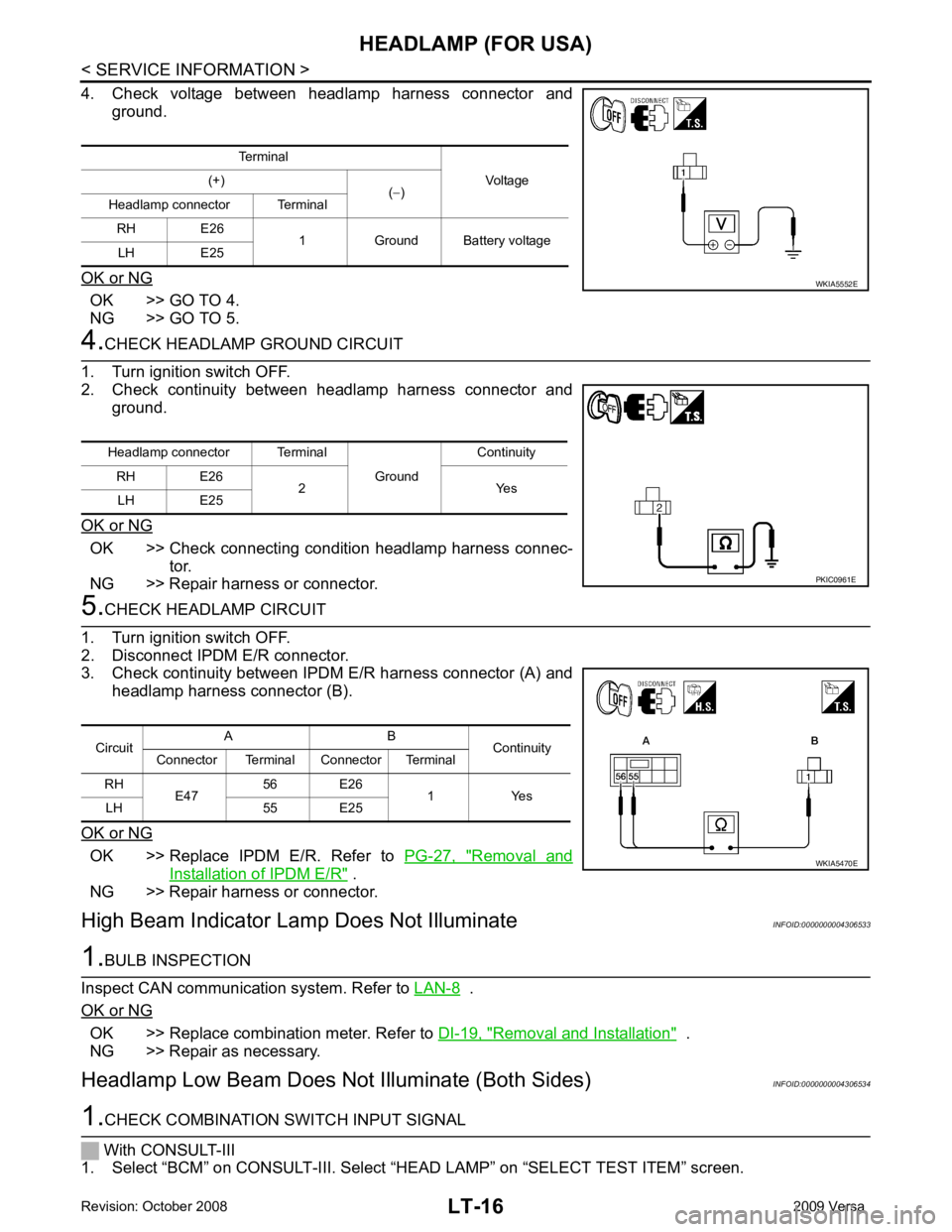2009 NISSAN LATIO ignition
[x] Cancel search: ignitionPage 3574 of 4331
![NISSAN LATIO 2009 Service Repair Manual CAN COMMUNICATION CIRCUIT
LAN-179
< COMPONENT DIAGNOSIS >
[CAN SYSTEM (TYPE 13)] C
D E
F
G H
I
J
L
M A
B LAN
N
O P
CAN COMMUNICATION CIRCUIT
Diagnosis Procedure INFOID:00000000047492961.
CONNECTOR INS NISSAN LATIO 2009 Service Repair Manual CAN COMMUNICATION CIRCUIT
LAN-179
< COMPONENT DIAGNOSIS >
[CAN SYSTEM (TYPE 13)] C
D E
F
G H
I
J
L
M A
B LAN
N
O P
CAN COMMUNICATION CIRCUIT
Diagnosis Procedure INFOID:00000000047492961.
CONNECTOR INS](/manual-img/5/57359/w960_57359-3573.png)
CAN COMMUNICATION CIRCUIT
LAN-179
< COMPONENT DIAGNOSIS >
[CAN SYSTEM (TYPE 13)] C
D E
F
G H
I
J
L
M A
B LAN
N
O P
CAN COMMUNICATION CIRCUIT
Diagnosis Procedure INFOID:00000000047492961.
CONNECTOR INSPECTION
1. Turn the ignition switch OFF.
2. Disconnect the battery cabl e from the negative terminal.
3. Disconnect all the unit connectors on CAN communication system.
4. Check terminals and connectors for damage, bend and loose connection.
Is the inspection result normal? YES >> GO TO 2.
NO >> Repair the terminal and connector. 2.
CHECK HARNESS CONTINUI TY (SHORT CIRCUIT)
Check the continuity between the data link connector terminals.
Is the inspection result normal? YES >> GO TO 3.
NO >> Check the harness and repair the root cause. 3.
CHECK HARNESS CONTINUI TY (SHORT CIRCUIT)
Check the continuity between the data link connector and the ground.
Is the inspection result normal? YES >> GO TO 4.
NO >> Check the harness and repair the root cause. 4.
CHECK ECM AND IPDM E/R TERMINATION CIRCUIT
1. Remove the ECM and the IPDM E/R.
2. Check the resistance between the ECM terminals.
3. Check the resistance between the IPDM E/R terminals.
Is the measurement value within the specification?YES >> GO TO 5.
NO >> Replace the ECM and/or the IPDM E/R. 5.
CHECK SYMPTOM
Connect all the connectors. Check if the symptoms descr ibed in the “Symptom (Results from interview with
customer)” are reproduced. Data link connector
Continuity
Connector No. Terminal No.
M22 6 14 Not existed Data link connector
GroundContinuity
Connector No. Terminal No.
M22 6 Not existed
14 Not existed ECM
Resistance (Ω)
Terminal No.
84 83 Approx. 108 – 132
IPDM E/R Resistance (Ω)
Terminal No.
41 40 Approx. 108 – 132 LKIA0037E
Page 3584 of 4331
![NISSAN LATIO 2009 Service Repair Manual CAN COMMUNICATION CIRCUIT
LAN-189
< COMPONENT DIAGNOSIS >
[CAN SYSTEM (TYPE 14)] C
D E
F
G H
I
J
L
M A
B LAN
N
O P
CAN COMMUNICATION CIRCUIT
Diagnosis Procedure INFOID:00000000047493141.
CONNECTOR INS NISSAN LATIO 2009 Service Repair Manual CAN COMMUNICATION CIRCUIT
LAN-189
< COMPONENT DIAGNOSIS >
[CAN SYSTEM (TYPE 14)] C
D E
F
G H
I
J
L
M A
B LAN
N
O P
CAN COMMUNICATION CIRCUIT
Diagnosis Procedure INFOID:00000000047493141.
CONNECTOR INS](/manual-img/5/57359/w960_57359-3583.png)
CAN COMMUNICATION CIRCUIT
LAN-189
< COMPONENT DIAGNOSIS >
[CAN SYSTEM (TYPE 14)] C
D E
F
G H
I
J
L
M A
B LAN
N
O P
CAN COMMUNICATION CIRCUIT
Diagnosis Procedure INFOID:00000000047493141.
CONNECTOR INSPECTION
1. Turn the ignition switch OFF.
2. Disconnect the battery cabl e from the negative terminal.
3. Disconnect all the unit connectors on CAN communication system.
4. Check terminals and connectors for damage, bend and loose connection.
Is the inspection result normal? YES >> GO TO 2.
NO >> Repair the terminal and connector. 2.
CHECK HARNESS CONTINUI TY (SHORT CIRCUIT)
Check the continuity between the data link connector terminals.
Is the inspection result normal? YES >> GO TO 3.
NO >> Check the harness and repair the root cause. 3.
CHECK HARNESS CONTINUI TY (SHORT CIRCUIT)
Check the continuity between the data link connector and the ground.
Is the inspection result normal? YES >> GO TO 4.
NO >> Check the harness and repair the root cause. 4.
CHECK ECM AND IPDM E/R TERMINATION CIRCUIT
1. Remove the ECM and the IPDM E/R.
2. Check the resistance between the ECM terminals.
3. Check the resistance between the IPDM E/R terminals.
Is the measurement value within the specification?YES >> GO TO 5.
NO >> Replace the ECM and/or the IPDM E/R. 5.
CHECK SYMPTOM
Connect all the connectors. Check if the symptoms descr ibed in the “Symptom (Results from interview with
customer)” are reproduced. Data link connector
Continuity
Connector No. Terminal No.
M22 6 14 Not existed Data link connector
GroundContinuity
Connector No. Terminal No.
M22 6 Not existed
14 Not existed ECM
Resistance (Ω)
Terminal No.
84 83 Approx. 108 – 132
IPDM E/R Resistance (Ω)
Terminal No.
41 40 Approx. 108 – 132 LKIA0037E
Page 3594 of 4331
![NISSAN LATIO 2009 Service Repair Manual CAN COMMUNICATION CIRCUIT
LAN-199
< COMPONENT DIAGNOSIS >
[CAN SYSTEM (TYPE 15)] C
D E
F
G H
I
J
L
M A
B LAN
N
O P
CAN COMMUNICATION CIRCUIT
Diagnosis Procedure INFOID:00000000047493321.
CONNECTOR INS NISSAN LATIO 2009 Service Repair Manual CAN COMMUNICATION CIRCUIT
LAN-199
< COMPONENT DIAGNOSIS >
[CAN SYSTEM (TYPE 15)] C
D E
F
G H
I
J
L
M A
B LAN
N
O P
CAN COMMUNICATION CIRCUIT
Diagnosis Procedure INFOID:00000000047493321.
CONNECTOR INS](/manual-img/5/57359/w960_57359-3593.png)
CAN COMMUNICATION CIRCUIT
LAN-199
< COMPONENT DIAGNOSIS >
[CAN SYSTEM (TYPE 15)] C
D E
F
G H
I
J
L
M A
B LAN
N
O P
CAN COMMUNICATION CIRCUIT
Diagnosis Procedure INFOID:00000000047493321.
CONNECTOR INSPECTION
1. Turn the ignition switch OFF.
2. Disconnect the battery cabl e from the negative terminal.
3. Disconnect all the unit connectors on CAN communication system.
4. Check terminals and connectors for damage, bend and loose connection.
Is the inspection result normal? YES >> GO TO 2.
NO >> Repair the terminal and connector. 2.
CHECK HARNESS CONTINUI TY (SHORT CIRCUIT)
Check the continuity between the data link connector terminals.
Is the inspection result normal? YES >> GO TO 3.
NO >> Check the harness and repair the root cause. 3.
CHECK HARNESS CONTINUI TY (SHORT CIRCUIT)
Check the continuity between the data link connector and the ground.
Is the inspection result normal? YES >> GO TO 4.
NO >> Check the harness and repair the root cause. 4.
CHECK ECM AND IPDM E/R TERMINATION CIRCUIT
1. Remove the ECM and the IPDM E/R.
2. Check the resistance between the ECM terminals.
3. Check the resistance between the IPDM E/R terminals.
Is the measurement value within the specification?YES >> GO TO 5.
NO >> Replace the ECM and/or the IPDM E/R. 5.
CHECK SYMPTOM
Connect all the connectors. Check if the symptoms descr ibed in the “Symptom (Results from interview with
customer)” are reproduced. Data link connector
Continuity
Connector No. Terminal No.
M22 6 14 Not existed Data link connector
GroundContinuity
Connector No. Terminal No.
M22 6 Not existed
14 Not existed ECM
Resistance (Ω)
Terminal No.
84 83 Approx. 108 – 132
IPDM E/R Resistance (Ω)
Terminal No.
41 40 Approx. 108 – 132 LKIA0037E
Page 3605 of 4331
![NISSAN LATIO 2009 Service Repair Manual LAN-210< COMPONENT DIAGNOSIS >
[CAN SYSTEM (TYPE 16)]
CAN COMMUNICATION CIRCUIT
CAN COMMUNICATION CIRCUIT
Diagnosis Procedure INFOID:00000000047493501.
CONNECTOR INSPECTION
1. Turn the ignition switch NISSAN LATIO 2009 Service Repair Manual LAN-210< COMPONENT DIAGNOSIS >
[CAN SYSTEM (TYPE 16)]
CAN COMMUNICATION CIRCUIT
CAN COMMUNICATION CIRCUIT
Diagnosis Procedure INFOID:00000000047493501.
CONNECTOR INSPECTION
1. Turn the ignition switch](/manual-img/5/57359/w960_57359-3604.png)
LAN-210< COMPONENT DIAGNOSIS >
[CAN SYSTEM (TYPE 16)]
CAN COMMUNICATION CIRCUIT
CAN COMMUNICATION CIRCUIT
Diagnosis Procedure INFOID:00000000047493501.
CONNECTOR INSPECTION
1. Turn the ignition switch OFF.
2. Disconnect the battery cable from the negative terminal.
3. Disconnect all the unit connectors on CAN communication system.
4. Check terminals and connectors for damage, bend and loose connection.
Is the inspection result normal? YES >> GO TO 2.
NO >> Repair the terminal and connector. 2.
CHECK HARNESS CONTI NUITY (SHORT CIRCUIT)
Check the continuity between t he data link connector terminals.
Is the inspection result normal? YES >> GO TO 3.
NO >> Check the harness and repair the root cause. 3.
CHECK HARNESS CONTI NUITY (SHORT CIRCUIT)
Check the continuity between the data link connector and the ground.
Is the inspection result normal? YES >> GO TO 4.
NO >> Check the harness and repair the root cause. 4.
CHECK ECM AND IPDM E/R TERMINATION CIRCUIT
1. Remove the ECM and the IPDM E/R.
2. Check the resistance between the ECM terminals.
3. Check the resistance between the IPDM E/R terminals.
Is the measurement value within the specification? YES >> GO TO 5.
NO >> Replace the ECM and/or the IPDM E/R. 5.
CHECK SYMPTOM
Connect all the connectors. Check if the symptoms descri bed in the “Symptom (Results from interview with
customer)” are reproduced. Data link connector
Continuity
Connector No. Terminal No.
M22 6 14 Not existed Data link connector
GroundContinuity
Connector No. Terminal No.
M22 6 Not existed
14 Not existed ECM
Resistance (Ω)
Terminal No.
84 83 Approx. 108 – 132
IPDM E/R Resistance (Ω)
Terminal No.
41 40 Approx. 108 – 132 LKIA0037E
Page 3609 of 4331

LT
N
O P
SERVICE INFORMATION
PRECAUTIONS
Precaution for Supplemental Restraint System (SRS) "AIR BAG" and "SEAT BELT
PRE-TENSIONER" INFOID:0000000004306519
The Supplemental Restraint System such as “A IR BAG” and “SEAT BELT PRE-TENSIONER”, used along
with a front seat belt, helps to reduce the risk or severi ty of injury to the driver and front passenger for certain
types of collision. This system includes seat belt switch inputs and dual stage front air bag modules. The SRS
system uses the seat belt switches to determine the front air bag deployment, and may only deploy one front
air bag, depending on the severity of a collision and w hether the front occupants are belted or unbelted.
Information necessary to service the system safely is included in the SRS and SB section of this Service Man-
ual.
WARNING:
• To avoid rendering the SRS inoper ative, which could increase the risk of personal injury or death in
the event of a collision which would result in air bag inflation, all maintenance must be performed by
an authorized NISSAN/INFINITI dealer.
• Improper maintenance, including in correct removal and installation of the SRS, can lead to personal
injury caused by unintentional act ivation of the system. For removal of Spiral Cable and Air Bag
Module, see the SRS section.
• Do not use electrical test equipm ent on any circuit related to the SRS unless instructed to in this
Service Manual. SRS wiring harnesses can be identi fied by yellow and/or orange harnesses or har-
ness connectors.
Precaution Necessary for Steering Wh eel Rotation After Battery Disconnect
INFOID:0000000004683900
NOTE:
• This Procedure is applied only to models with Inte lligent Key system and NATS (NISSAN ANTI-THEFT SYS-
TEM).
• Remove and install all control units after disconnecti ng both battery cables with the ignition knob in the
″ LOCK ″ position.
• Always use CONSULT-III to perform self-diagnosis as a part of each function inspection after finishing work.
If DTC is detected, perform trouble diagnosis according to self-diagnostic results.
For models equipped with the Intelligent Key system and NATS , an electrically controlled steering lock mech-
anism is adopted on the key cylinder.
For this reason, if the battery is disconnected or if the battery is discharged, the steering wheel will lock and
steering wheel rotation will become impossible.
If steering wheel rotation is required when battery pow er is interrupted, follow the procedure below before
starting the repair operation.
OPERATION PROCEDURE 1. Connect both battery cables. NOTE:
Supply power using jumper cables if battery is discharged.
2. Use the Intelligent Key or mechanical key to turn the ignition switch to the ″ACC ″ position. At this time, the
steering lock will be released.
3. Disconnect both battery cables. The steering lock will remain released and the steering wheel can be
rotated.
4. Perform the necessary repair operation.
5. When the repair work is completed, return the ignition switch to the ″LOCK ″ position before connecting
the battery cables. (At this time, the steering lock mechanism will engage.)
6. Perform a self-diagnosis check of al l control units using CONSULT-III.
Page 3617 of 4331

LT
N
O P
How to Perform Trouble Diagnosis
INFOID:0000000004306527
1. Confirm the symptom or customer complaint.
2. Understand operation, description and function description. Refer to LT-4, " System Description " .
3. Perform the Preliminary Check. Refer to LT-11, " Preliminary Check " .
4. Check symptom and repair or replace the cause of the malfunction.
5. Do the headlamps operate normally? If YES, GO TO 6. If NO, GO TO 4.
6. INSPECTION END
Preliminary Check INFOID:0000000004306528
CHECK POWER SUPPLY AND GROUND CIRCUIT FOR BCM Refer to BCS-15, " BCM Power Supply and Ground Circuit Inspection " .
CHECK POWER SUPPLY AND GROUND CIRCUIT FOR IPDM E/R Refer to PG-26, " IPDM E/R Power/Ground Circuit Inspection " .
CONSULT-III Function (BCM) INFOID:0000000004306529
CONSULT-III can display each diagnostic item using the diagnostic test modes shown following.
WORK SUPPORT
Display Item List
DATA MONITOR
Display Item List BCM diagnostic
test item Diagnostic mode Description
Inspection by part WORK SUPPORT
Supports inspections and adjustments. Commands are transmitted to the BCM for
setting the status suitable for required operation, input/output signals are received
from the BCM and received data is displayed.
DATA MONITOR Displays BCM input/output data in real time. ACTIVE TEST Operation of electrical loads can be checked by sending drive signal to them.
SELF-DIAG RESULTS Displays BCM self-diagnosis results.
CAN DIAG SUPPORT MNTR The result of transmit/receive diagnosis of CAN communication can be read. ECU PART NUMBER BCM part number can be read.
CONFIGURATION Performs BCM configuration read/write functions. Item Description CONSULT-III Factory setting
BATTERY SAVER SET Exterior lamp battery saver control mode can be changed
in this mode. Selects exterior lamp battery saver control
mode between ON/OFF. ON
×
OFF — Monitor item Contents
IGN ON SW "ON/OFF" Displays "IGN position (ON)/OFF, ACC position (OFF)" judged from the ignition switch signal.
ACC ON SW "ON/OFF" Displays "ACC (ON)/OFF, Ignition OFF (OFF)" status judged from ignition switch signal.
HI BEAM SW "ON/OFF" Displays status (high beam switch: ON/Others: OFF) of high beam switch judged from lighting
switch signal.
HEAD LAMP SW 1 "ON/OFF" Displays status (headlamp switch 1: ON/Others: OFF) of headlamp switch 2 judged from lighting
switch signal.
HEAD LAMP SW 2 "ON/OFF" Displays status (headlamp switch 2: ON/Others: OFF) of headlamp switch 2 judged from lighting
switch signal.
Page 3619 of 4331

LT
N
O P
NOTE:
Perform monitoring of IPDM E/R data with the ignition swit ch ON. When the ignition switch is at ACC, the dis-
play may not be correct.
ACTIVE TEST
Headlamp High Beam Does No t Illuminate (Both Sides) INFOID:0000000004306531Combination Switch Inspection " .
OK or NG OK >> GO TO 2.
NG >> Check combination switch (lighting switch). Refer to LT-63, " Combination Switch Inspection " .
Auto Active Test " .
2. Make sure headlamp high beam operates. Item name
CONSULT-III screen
display Display or
unit Monitor item selection
Description
ALL
SIGNALS MAIN
SIGNALS SELECTION
FROM MENU
Parking, license plate
and tail lamps request TAIL&CLR REQ ON/OFF
× × ×Signal status input from BCM
Headlamp low beam re-
quest HL LO REQ ON/OFF
× × × Signal status input from BCM
Headlamp high beam re-
quest HL HI REQ ON/OFF
× × × Signal status input from BCM
Front fog lamps request FR FOG REQ ON/OFF × × ×Signal status input from BCM
Daytime light request DTRL REQ ON/OFF x x x Signal status input from BCM Test item CONSULT-III screen display Description
Tail lamp relay output TAIL LAMP Allows tail lamp relay to operate by switching operation ON-OFF at your
option.
Headlamp relay (HI, LO) out-
put LAMPSAllows headlamp relay (HI, LO) to operate by switching operation (OFF,
HI, LO) at your option (Head lamp high beam repeats ON-OFF every 1
second).
Front fog lamp relay (FOG)
output Allows fog lamp relay (FOG) to operate by switching operation ON-OFF
at your option. Headlamp high beam should operate
(Headlamp high beam repeats ON–OFF every 2 sec-
onds).
Page 3622 of 4331

LT-16< SERVICE INFORMATION >
HEADLAMP (FOR USA)
4. Check voltage between headlamp harness connector and ground.
OK or NG OK >> GO TO 4.
NG >> GO TO 5. 4.
CHECK HEADLAMP GROUND CIRCUIT
1. Turn ignition switch OFF.
2. Check continuity between headlamp harness connector and ground.
OK or NG OK >> Check connecting condition headlamp harness connec-
tor.
NG >> Repair harness or connector. 5.
CHECK HEADLAMP CIRCUIT
1. Turn ignition switch OFF.
2. Disconnect IPDM E/R connector.
3. Check continuity between IPDM E/R harness connector (A) and
headlamp harness connector (B).
OK or NG OK >> Replace IPDM E/R. Refer to
PG-27, " Removal and
Installation of IPDM E/R " .
NG >> Repair harness or connector.
High Beam Indicator Lam p Does Not Illuminate INFOID:00000000043065331.
BULB INSPECTION
Inspect CAN communication system. Refer to LAN-8 .
OK or NG OK >> Replace combination meter. Refer to
DI-19, " Removal and Installation " .
NG >> Repair as necessary.
Headlamp Low Beam Does Not Illuminate (Both Sides) INFOID:00000000043065341.
CHECK COMBINATION SWITCH INPUT SIGNAL
With CONSULT-III
1. Select “BCM” on CONSULT-III. Select “HEAD LAMP” on “SELECT TEST ITEM” screen.
Terminal
Voltage
(+)
(− )
Headlamp connector Terminal
RH E26 1 Ground Battery voltage
LH E25 WKIA5552E
Headlamp connector Terminal
Ground Continuity
RH E26 2 Yes
LH E25 PKIC0961E
Circuit
A B
Continuity
Connector Terminal Connector Terminal
RH E47 56 E26
1 Yes
LH 55 E25 WKIA5470E